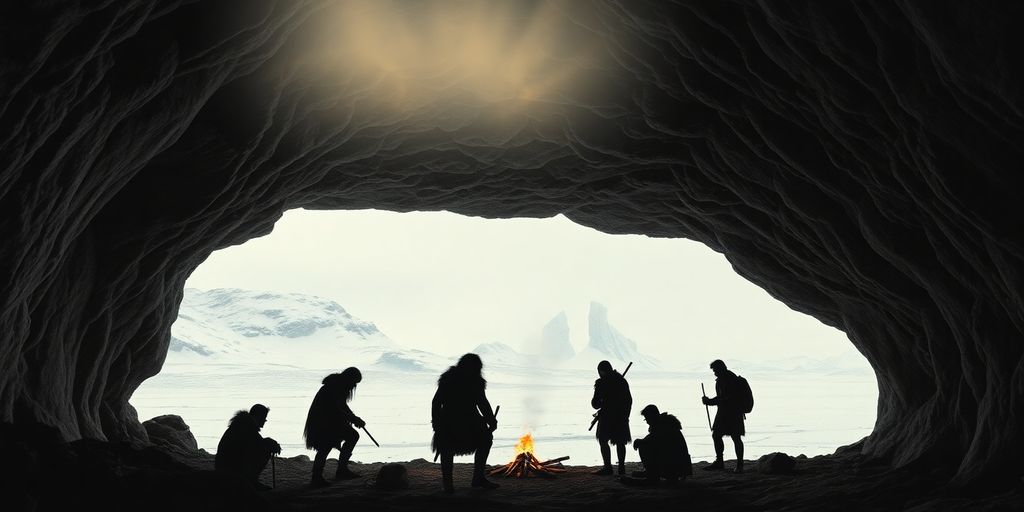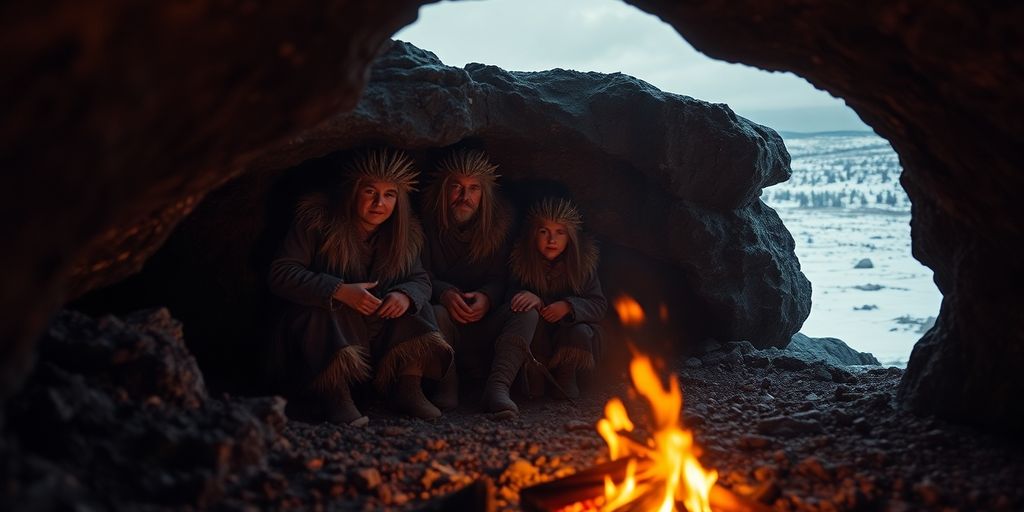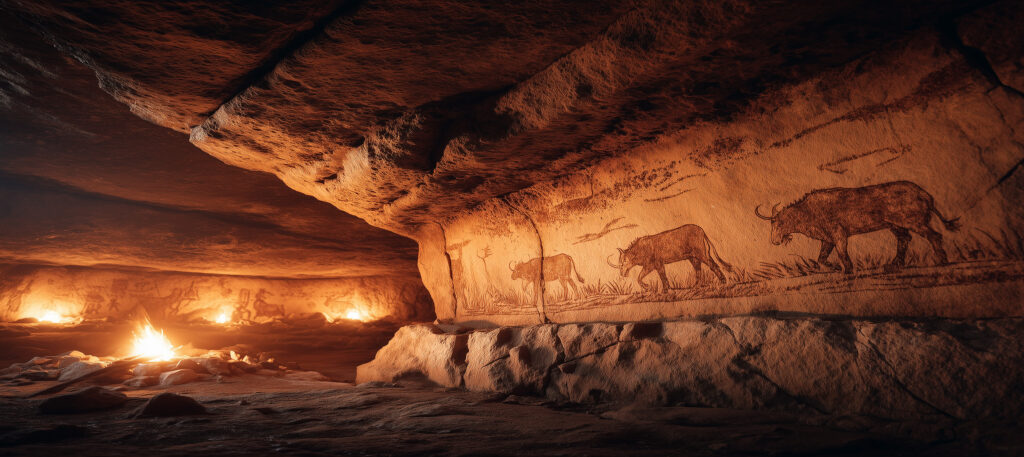Surviving the Past
Life and Shelter in Prehistoric Times
🎧Hit play and watch phrasal verbs come alive in real-life
PHRASAL VERBS DICTIONARY
🌱Build your English with phrasal verbs used in real survival and shelter contexts.
Unearthing Prehistoric Life
Piecing Together the Past
Ever wonder what life was like way back when? Like, before smart phones, cars, or even houses? Our ancestors had to figure out how to make it work with what they had. This article will take a look at how people lived, found shelter, and survived in prehistoric times. We’ll check out how they dealt with daily challenges and built their lives from scratch, focusing on how they used phrasal verbs in context to describe their actions and surroundings.
So, how do we even begin to understand what life was like way back before anyone was writing stuff down? It’s a puzzle, for sure. Archaeologists and anthropologists are like detectives, piecing together clues from, well, really old stuff. They dig up artifacts – tools, pottery, even old garbage – and fossils, which are the remains of plants and animals that have turned to stone over, like, millions of years. They test these things, analyze them, and try to figure out what they tell us about how people lived, what they ate, and what they believed. It’s not an exact science, and sometimes they get it wrong, but it’s the best we’ve got.

📌 Phrasal Verbs in Action
- figure out – understand or solve
They had to figure out how to survive. - dig up – discover by digging
Archaeologists dig up old artifacts. - deal with – manage, handle
They had to deal with harsh climates.
So, how do we even begin to understand what life was like way back before anyone was writing stuff down? It’s a puzzle, for sure. Archaeologists and anthropologists are like detectives, piecing together clues from, well, really old stuff. They dig up artifacts – tools, pottery, even old garbage – and fossils, which are the remains of plants and animals that have turned to stone over, like, millions of years. They test these things, analyze them, and try to figure out what they tell us about how people lived, what they ate, and what they believed. It’s not an exact science, and sometimes they get it wrong, but it’s the best we’ve got.
Shelter Strategies

Early humans weren’t exactly building McMansions, but they were pretty resourceful when it came to finding or creating shelter. The earliest forms of dwellings were often natural shelters like caves or rock overhangs. Adaptation was key. They’d use what was available, improving upon it with branches, animal hides, and whatever else they could find. Think of it as the original tiny home movement, but with a lot more dirt and a lot fewer Instagram posts.
Building wasn’t just about comfort; it was about survival. A good shelter could keep out predators, harsh weather, and other dangers. It also provided a central place for the group to come together, share out food, and build up social bonds that helped them get through the hardest times.
Here’s a quick look at some materials early humans used to set up their shelters and keep out the cold, wind, and wild animals. They would often make use of animal hides to cover up their shelters and add insulation. Branches and thatch were gathered to build up walls and roofs, offering basic protection from the elements. Stones were used to lay out sturdy foundations, while bones — especially in places where wood was hard to come by — were used to hold up parts of the structure.
Shelters weren't just structures; they were a symbol of community and a testament to human ingenuity. They represented safety, security, and the collective effort to overcome the challenges of a prehistoric world.
📌 Phrasal Verbs in Action
- set up – build or arrange
They set up temporary shelters. - keep out – prevent from entering
Shelters helped keep out wild animals. - share out – divide among people
They shared out the food.
Social Bonds and Group Survival

Living in prehistoric times wasn’t a solo mission — it was all about community. Think about it: facing woolly mammoths or trying to get through a harsh winter alone? Not a great plan. Early humans realized that sticking together greatly brought up their chances of survival. They set up groups not just for hunting, but for protection, companionship, and emotional support. These communities didn’t always work out perfectly, but they were essential. The size of each group depended on available resources and the environment. Still, every group helped individuals feel part of something bigger, which made it easier to deal with the harsh challenges of their world, from extended families to bands of around 100 people, depending on the resources available and the environment. These groups fostered a sense of belonging and mutual support, which was vital for navigating the challenges of their world.
Because they were always on the move, permanent settlements were out of the question for many prehistoric groups. Their homes were temporary, put together from whatever materials were available — animal hides, branches, or even snow. These shelters were designed to be easy to set up and quick to take down when it was time to leave. The idea of holding on to land or building a lasting structure didn’t really fit in with their lifestyle. Their focus was on the present — looking for food and shelter each day, and moving on when resources ran out. This impermanence shaped their culture, emphasizing community and cooperation over material possessions.
LOOKING FOR EXERCISES
Unearthing Prehistoric Life
Click on each question below to reveal the suggested answer.
Try to think about your own answer before opening it.
Practice using the phrasal verbs naturally and build your confidence!
Why did early humans stick together instead of living alone?
Because sticking together increased their chances of survival.
They could hunt, share resources, protect one another, and build social bonds.
What does the phrasal verb “figure out” mean in the text?
It means to understand or solve something. In the text,
early humans had to figure out how to survive using what they had.
Why were early human shelters designed to be temporary?
Because prehistoric groups were constantly on the move.
They needed shelters they could quickly set up and take down as they moved on to find new resources.
How did prehistoric people make use of their environment?
They used whatever was available to build shelters —
animal hides, bones, branches, stone, even snow.
They made use of every resource they could find.
In what ways did community life help people get through hard times?
Living in groups allowed people to share out food, look after each other,
and get through challenges like illness, cold weather, and danger.
